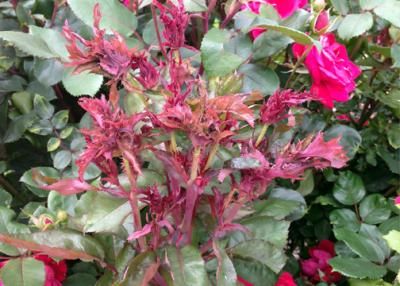What is Rose Rosette Disease?
Rose Rosette Disease (RRD) is caused by a virus called Rose Rosette Virus, which is carried by eriophyid mites. RRD was first discovered in wild rose bushes during the 1940’s. The disease has not been found to exist in any other plant species other than roses. Though RRD has been around for decades, it has only recently (in the past 2-3 years) begun to aggressively attack the Knock Out Roses of our region.
Research is currently being done to help stop and prevent Rose Rosette Disease. This year, the U.S. Department of Agriculture’s National Institute of Food and Agriculture (NIFA) has awarded $4.6 million in funding to address this issue.
What Causes Rose Rosette Disease?
RRD is caused by the Rose Rosette Virus (RRV) which is transmitted by eriophyid mites. Eriophyid mites are microscopic pest that hide in buds, at the base of shoots, leaf axils, and under leaf scars. These mites are so tiny, they are easily carried by the wind. This is perhaps how the disease is able to spread so rapidly. Mites carrying RRV contract the virus by feasting on an infected plant. Infected mites then carry on the virus on to healthy plants.
In addition to wind carrying the mites from plant to plant, infected mites can be transported via contaminated clothing and tools. Plants typically begin to show symptoms within 1-3 months after becoming infected.
What Are the Symptoms of Rose Rosette Disease?
- Elongated stems
- Excessive thorns
- Unusually red stems
- A brush-like cluster of branching that originates from a certain point. This is often referred to as a “witches broom” as it resembles a witches broom.
- Stunted / distorted growth
- Molting / yellowing of branches
- Distorted or discolored blooms
- New shoots that are often thicker than the branch from which they originated
- Defoliation
- Dieback
Symptoms will worsen and plants will decline over time. Plants typically die within 2-3 years of beginng to show symptoms of RRD.
How Is Rose Rosette Disease Diagnosed?
If your rose bush exhibits any of the above symptoms please follow the treatment procedures below as quickly as possible to prevent the spread of this disease to other rose bushes both in your yard and in neighboring yards. If you are not sure whether or not your rose has RRD, you can send a photo of your rose in question to social@matthewmurrey.com and we can assist you in getting your plant diagnosed, or you may place a clipping inside a sealed ziplock bag and take it to your local nursery for diagnosis.
How do you Treat Rose Rosette Disease?
There is no known cure or chemical treatment for Rose Rosette Disease.
The most effective and only proven method for controlling Rose Rosette Disease is to dig up the entire infected bush (roots and all) at the first signs of RRD symptoms. The sooner plants have been removed, the better the chance that RRD will not be spread to nearby roses. Discard the removed roses in a landfill (or burn them). Do not use these roses as compost.
Be sure to disinfect the garden tools that have been used to prune and remove the affected plants with rubbing alcohol or hydrogen peroxide.
Some growers and gardeners have attempted to prune out all of the stems and branches exhibiting symptoms, but this has only proven effective 50% of the time.
Again, if you decide to pursue this route, be sure to disinfect the garden tools that have been used to prune and remove the affected plants with rubbing alcohol or hydrogen peroxide.
Recently, Howard Garrett, a famous Dallas radio show host, landscape architect and organic garden guru instructed one of his listeners try the following all-organic approach to treating her infected roses. Click here to see the full story along with results.
- Cut away the diseased stems and clean the tool blades immediately using hydrogen peroxide (never bleach).
- Apply The Sick Tree Treatment throughout all the rose beds.
- Choose one of the following spray formulas:
- To 1 gallon of spray with Garrett Juice Plus add 8 ounces of 3 percent hydrogen peroxide (available at drug and grocery stores).
- To Garrett Juice Plus spray add 2 ounces of orange oil.
- To Garrett JuicePlus spray add 1 tablespoon of Bio Wash.
- Spray the plants thoroughly.
Again, please note that the only tried and true method proven to rid your yard of Rose Rosette disease is the total removal and proper disposal of infected roses.
How do you Prevent Rose Rosette Disease?
Though there are no proven ways to prevent Rose Rosette Disease, here are some helpful tips to help keep roses in their best health as healthy roses are better at protecting themselves from disease.
- Keep plants healthy – feed and water them regularly. Stressed plants are more susceptible to disease.
- Heavily prune roses in late winter. Find pruning instructions here.
More Information on Rose Rosette:
- http://pods.dasnr.okstate.edu/docushare/dsweb/Get/Document-9207/EPP-7329web.pdf
- http://plantclinic.tamu.edu/2011/07/13/rose-rosette/

